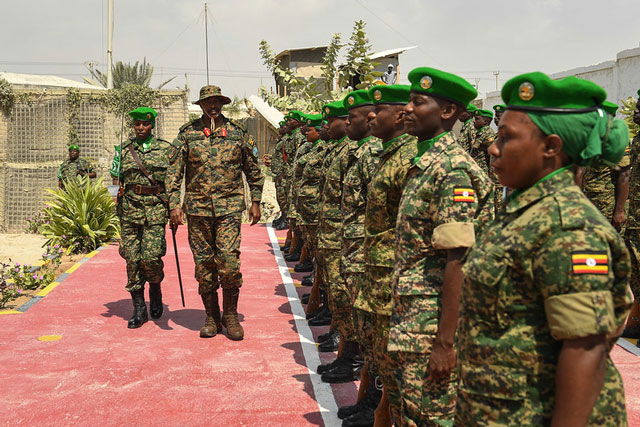
Why Uganda should stop deluding itself that it is in Somalia to protect the people of that country
THE LAST WORD | Andrew M. Mwenda | Last week in this column, I argued that Uganda’s mission in Somalia is like America’s mission in Afghanistan. This lesson was hammered into my head reading a book by an American journalist, Craig Whitlock titled The Afghanistan Papers. You could as well remove the world Afghanistan and replace it with Somalia and replace USA with Uganda and AMISON with NATO. The story is not just similar. It is the same – an intervention that imagines an enemy of the people different from what the people think.
I argued last week that Al Shabab is respected by Somalis more than the government we are propping. Based on its activities, it is a child and representative of the Somali people. It survives and thrives because it enjoys popular support. Western countries and their propaganda machinery prefer to paint it as the enemy of the people because it is Islamist. But most Somalis like al Shabab precisely because it is Islamist. Uganda and the AU should avoid the trap of using western lenses to judge al Shabab.
At any rate, the Americans learnt this painful lesson in Afghanistan. After 20 years of war against the Taliban, they had to withdraw and let the Taliban take over power. The occupation of Afghanistan cost the USA $2.06 trillion spent trying to rebuild that country and make it hostile to the Taliban, of which $800 billion was specifically to build an Afghan national army to fight the Taliban. That army collapsed within one week of American withdrawal.
Uganda can as well stay in Somalia for the next 50 years but it will never defeat the Al Shabab. Al Shabab is the policeman in the SNP, the soldier in the SNA, the teacher in a government school, the nurse and doctor in the hospital, the vendor on the street, the shopkeeper in town, the taxi driver, the waiter in a restaurant, the news vendor on the street. In short Al Shaban is the people of Somalia. In positioning ourselves to be fighting Al Shabab we are actually fighting the people of Somalia even though we delude ourselves into the belief that we are protecting them.
Uganda should ask itself: what is our mission in Somalia? What is our main aim? We are there to help establish a national government. But what we are propping as a national government is actually a corrupt and incompetent sham that lacks legitimacy in the eyes of the people. It is like Nigeria coming to Uganda in October 1985 to prop the Okello-Okello government against the National Resistance Movement/Army (NRM/A).
Uganda has failed to define its interests and mission in Somalia in a clear way. When we say we are in Somalia to protect the people, against whom are we protecting them? Al Shabab? That is a huge mistake because the people of Somalia do not see Al Shabab as an enemy against whom they need protection. In fact for most of their lives, the people of Somalia need protection from the government backed by us, with all its corruption and violence by its soldiers. In fighting Al Shabab we are fighting the Somali people and their legitimate interests and representatives. We can delude ourselves otherwise but that is the painful truths.
President Yoweri Museveni has articulated the view that Uganda is in Somalia on a pan African mission. But do Somalis appreciate Pan African ideology? From my interactions with them, I found Somalis filled with a pan Islamist ideology, or many a pan Somali ideology. So we are acting like colonialists trying to impose our ideological aspirations on a people who do not appreciate them and are not interested in them.
Every time I interviewed somalis in Mogadishu they asked me what UPDF was doing in their country. “We in Somalia are Muslims” they would tell me “but you guys in Uganda are not Muslims. You are Christians. You work with Americans and Europeans, Christians like you. And we don’t like Americans and Europeans here in Somalia because they hate Islam, they want to destroy our religion. Islam is our way of life. So we hate the Americans and Europeans because they want to destroy our way of life.”
So while we claim to be in Somalia to protect the people against Al Shabab, the people see us as agents of foreign powers seeking to destroy their way of life. Our claims to be in Somalia to protect the people there from Al Shabab ring hollow these days because we have recently withdrawn from Jamale and left Al Shabab to take over. So who is now protecting the people of Jamale from Al Shabab? How come they are not complaining since Al Shabab took over? The same applies to Continuale, Barire and Lantubur.
Al Shabab controls most of Somalia. Are we saying the population in its areas of control is not safe? In fact from my experience most people in government held areas feel unsafe compared to people in Al Shabab held areas. Why? Because the SNA terrorizes them and the government steals from them.
Finally, there is this false feeling that the government of Somalia backed by AMISOM controls Mogadishu. This stands in the face of the fact that no UPDF or AMISOM soldier can walk freely on the streets of Mogadishu without getting killed. If the government of Somalia has any power, why can’t it provide security to those guarding it? Somalia is a complex polyglot of shifting alliances and multilayered conflicts. UPDF, like the Americans in Afghanistan and Iraq, has constantly found itself fighting battles with other groups who are not Al Shabab but who ally with it for tactical reasons depending on circumstances and opportunity.
Next week, I will return to this subject with specific examples of how the multilayered ethnic and clan conflicts in Somalia and the shifting alliances among its clans and subclans make it almost impossible for UPDF, the AU and their Western backers to make meaningful change in that country. For now, we can ask Museveni the following questions: what is Uganda’s main political objectives in Somalia? Within which timeframe do we expect them to be achieved? What are the key success indicators and result areas which, when achieved, will lead to our withdraw? Ugandan troops have been in Somali since 2007. That is 17 years. What have we achieved so far? Isn’t this a mission without a clearly defined end-goal and equally a clear exit strategy? Are we not groping in the dark?
*****

The post Uganda’s Somalia adventure 2 appeared first on The Independent Uganda:.



